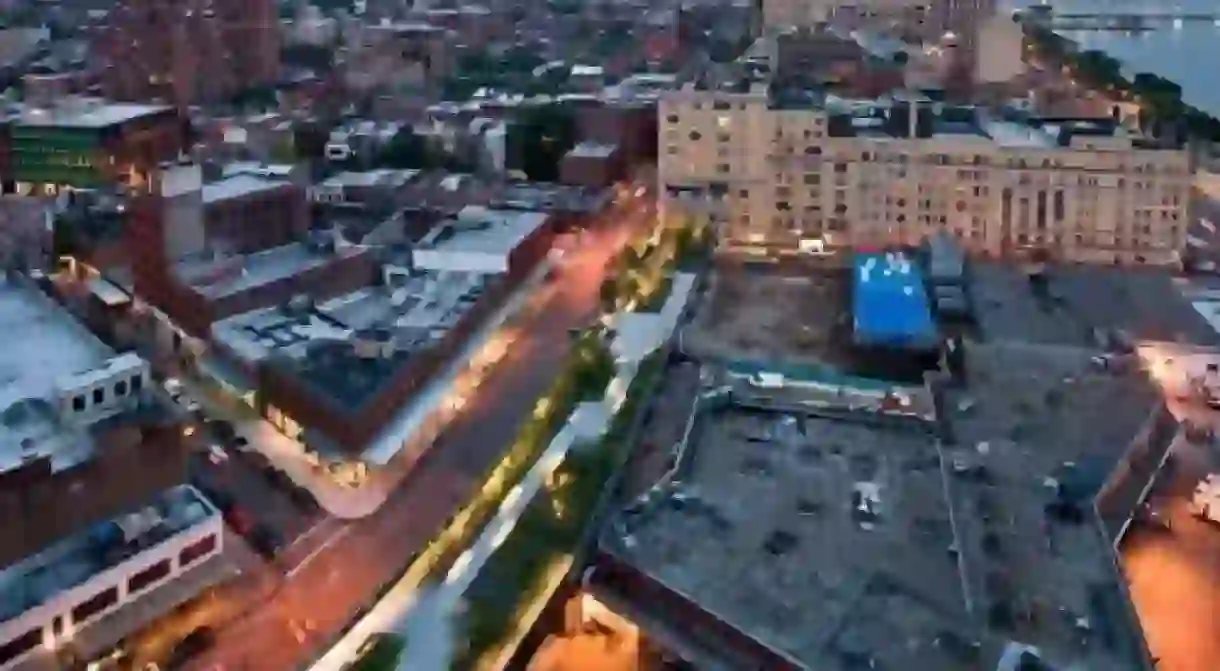The High Line: An Elevated Oasis

High Line Art promotes public contemporary art in a lush, elevated refuge in the center of New York’s gallery district. Artists are invited to engage with the history and design of the area through unique and highly site specific projects. Kirsten Nicholas gives an insiders’ account of this growing platform for art in the city.

Thirteen years ago a simple impulse initiated an innovative idea that transformed Manhattan’s West Side. The desire to preserve a historic treasure led to the creation of a contemporary landmark, The High Line. This elevated park now stands as a testament to New York’s colorful past and visionary future.
Situated 30 feet above the busy roadways of Manhattan, The High Line serves as a public, green space attracting thousands of visitors every year. Originally an elevated railroad built in the 1930s, The High Line aimed to alleviate street level traffic and improve safety while transporting goods. As interstate trucking became the preferred shipping method, the High Line fell into disuse with the last train running in 1980.
When property owners lobbied for demolition, neighborhood residents Joshua David and Robert Hammond founded the non-profit organisation Friends of the High Line in 1999 to advocate for the structure’s preservation and reuse as a public space. Upon gaining city support they held an open ideas competition in 2003, ‘Designing the High Line’. 720 teams from 36 countries submitted proposals ranging from the ordinary to the extraordinary. Looking to commemorate the past while creating a new city escape, Friends of the High Line and the City of New York chose the landscape architecture firm James Corner Field Operations and the architecture firm Diller Scofido + Renfro, which specialises in horticulture, public art, and other disciplines.

Their creative, elegant design preserves the past by seamlessly incorporating portions of the track into the modified landscape while the presence of opened seated vistas encourages relaxing, contemplative visits. A carefully chosen selection of plants, inspired by the wild landscape that grew on the unused tracks, surrounds a designated walkway. This fragrant ode to the endurance of nature creates a lush environment where busy locals can find respite or curious tourists can explore. While the layout is highly stylised, the park feels unassuming and simple. The beauty in this simplicity is accessibility; now everyone can not only enjoy the elevated rails but also appreciate the power of a modest idea.
After ten years of fundraising, planning, promoting, and constructing, the first portion of the High Line, extending from Gansevoort Street to West 20th, opened in June 2009. The second section, from West 20th to West 30th opened in June 2011. The dream is finally a reality and proves to be better than imagined. Friends of the High Line continues to push boundaries with innovative community engagement and a unique public art programme.

From the beginning the organisation has aimed to produce public art programmes, which have since become a staple along the elevated grounds. In the past year, High Line Art has grown exponentially with works now situated throughout the entire park. Curator and Director of High Line Art, Cecilia Alemani, has brought fresh, innovative ideas to the park’s programme that are challenging the accepted notions of public art. Straying away from merely monumental works to garner attention, Alemani has devised a four-pronged program that pioneers emerging artists and celebrates established stars.
High Line Billboard is a rotating series where every other month an artist’s work is super-sized, and floats next to the railway, attracting keen attention from visitors. By projecting two videos each month, High Line Channel animates the façades of adjacent buildings. High Line Commission places sculptures for at least a year in areas both obvious and hidden to inspire fun looking. And High Line Performance transforms the park into a stage for fun and quirky shows.
This multi-disciplinary public art programme creates an open aired contemporary museum in the heart of New York’s art district. The Whitney Museum of American Art is relocating next to the High Line and slated to open in 2015, further signifying the area’s cultural growth. As the High Line’s neighborhood slowly transforms, community outreach and engagement will remain crucial.

The presence of public housing projects throughout the park’s neighborhood is a cornerstone of their community programmes. Forging strong relationships with these areas has led to the creation of teen councils, young adult volunteer groups, and inclusive family programmes that aim to make the High Line part of their home. In addition to this specific programming, Friends of the High Line organises a range of public outreach projects. Walking tours, lectures, movie nights, hands-on family activities, and holiday themed endeavors are a few of the hot ticket items that have transformed the park into a local hotspot and a cultural attraction.
Since the High Line’s success stems from the merging of multiple disciplines – design, history, horticulture, and art, the organisation aims to incorporate these fields into their public programmes. Willing volunteers and dedicated employees constantly aim to educate and engage with the community and with tourists about the park’s past, creation, and future.
Serving as a model to public works projects worldwide, the success of the High Line has reinvigorated discussions around land reclamation and reuse. The final portion of the structure, the Rail Yards running from West 30th to West 34th, secured the parks renown and will continue to grow. When fully completed, this 1.45-mile long formation will serve as an elevated oasis where visitors can escape, discover, and enjoy the city’s history and future.
By Kirsten Nicholas
Images courtesy: Friends of the High Line.













